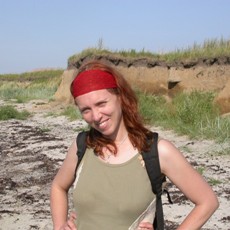Network Member Profiles
Gill Plunkett, University College, Dublin.
Biography
Gill obtained a BA in Archaeology and Psychology from University College Dublin in 1992, an MSc in Archaeology & Palaeoecology from Queen's University Belfast in 1996 and a PhD from Queen's University Belfast in 1999. She was a Research Fellow in Queen's University Belfast from 2002-2007 and has been Lecturer in Palaeoecology, Queen's University Belfast, from 2007 to the present. Gill's research interests include Irish prehistory and Early medieval periods, Holocene climate change, impact of past climate change on cultures, impact of past human activity on the environment and wetland archaeology.
Contact
g.plunkett@qub.ac.uk
Research Interests
Irish prehistory - Irish Early Medieval period - palynology - tephrochronology - wetland/peatland archaeology - archaeobotany - Holocene climate change.
Themes
Earth, Air, Water.
Selected Publications
Coulter, S.E., Pilcher, J.R., Hall, V.A., Plunkett, G. and Davies, S.M. (in press) Testing the reliability of the JEOL FEGSEM 6500F electron microprobe for quantitative major element analysis of glass shards from rhyolitic tephra, Boreas.
Kerr, T.R., Swindles, G.T. and Plunkett, G. (2009) Making hay while the sun shines? Socio-economic change, cereal production and climatic deterioration in Early Medieval Ireland, Journal of Archaeological Science, 36, 2868-2874.
Swindles, G.T. and Plunkett, G. (in press) Testing the palaeoclimate significance of the Northern Irish bog oak record, The Holocene.
Plunkett, G. 2009 Land-use patterns and cultural change in the Middle to Late Bronze Age in Ireland: inferences from the pollen record, Vegetation History and Archaeobotany, 18, 273-295.
Plunkett, G., Whitehouse, N.J., Hall, V.A., Charman, D.J., Blaauw, M., Kelly, E. and Mulhall, I. (2009) A multi-proxy palaeoenvironmental investigation of the findspot of an Iron Age bog body from Oldcroghan, Co. Offaly, Ireland, Journal of Archaeological Science, 36, 265-277.
Plunkett, G. and Swindles, G.T. (2008) Determining the Sun's influence on Late Glacial and Holocene climates: a focus on climate response to centennial-scale solar forcing at 2800 cal. B.P., Quaternary Science Reviews, 27, 175-184.
Plunkett, G., Carroll, F., Hartwell, B., Whitehouse, N.J. and Reimer, P.J. (2008) Vegetation history at the multi-period prehistoric complex at Ballynahatty, Co. Down, Northern Ireland, Journal of Archaeological Science, 35, 181-190.
Swindles, G.T., Plunkett, G. and Roe, H. (2007) A multi-proxy climate record from a raised bog in County Fermanagh, Northern Ireland: a critical examination of the link between bog surface wetness and solar variability, Journal of Quaternary Science, 22, 667-679.
Swindles, G.T., Plunkett, G. and Roe, H. (2007) A delayed climatic response to solar forcing at 2800 cal. BP: multi-proxy evidence from three Irish peatlands, The Holocene, 17, 177-182.
Plunkett, G. (2006) Tephra-linked peat humification records from Irish ombrotrophic bogs question nature of solar forcing at 850 cal. BC, Journal of Quaternary Science, 21, 9-16.
Plunkett, G. and Foley, C. (2006) Peatland archaeology in Northern Ireland: an evaluation, Journal of Wetland Archaeology, 6, 83-97.
Plunkett, G.M., Pilcher, J.R., McCormac, F.G. and Hall, V.A. (2004) New dates for first millennium BC tephra isochrones in Ireland, The Holocene, 14, 780-786.
Plunkett, G.M., Whitehouse, N.J., Hall, V.A., Brown, D.M. and Baillie, M.G.L. (2004) A precisely-dated lake-level rise marked by diatomite formation in northeastern Ireland, Journal of Quaternary Science, 19, 3-7.
Murray, E., McCormick, F. and Plunkett, G. (2004) The food economies of Atlantic island monasteries: the documentary and archaeo-environmental evidence, Environmental Archaeology, 9, 179-189.
Whitehouse, N.J., Murphy, E.M. and Plunkett, G. (2004) Human exploitation and biota of islands, Environmental Archaeology, 9, 113-115.


